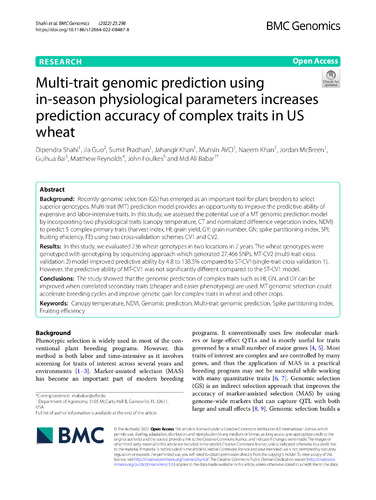Multi-trait genomic prediction using in-season physiological parameters increases prediction accuracy of complex traits in US wheat
Abstract
Background: Recently genomic selection (GS) has emerged as an important tool for plant breeders to select superior genotypes. Multi-trait (MT) prediction model provides an opportunity to improve the predictive ability of expensive and labor-intensive traits. In this study, we assessed the potential use of a MT genomic prediction model by incorporating two physiological traits (canopy temperature, CT and normalized difference vegetation index, NDVI) to predict 5 complex primary traits (harvest index, HI; grain yield, GY; grain number, GN; spike partitioning index, SPI; fruiting efiiciency, FE) using two cross-validation schemes CV1 and CV2. Results: In this study, we evaluated 236 wheat genotypes in two locations in 2 years. The wheat genotypes were genotyped with genotyping by sequencing approach which generated 27,466 SNPs. MT-CV2 (multi-trait cross validation 2) model improved predictive ability by 4.8 to 138.5% compared to ST-CV1(single-trait cross validation 1). However, the predictive ability of MT-CV1 was not significantly different compared to the ST-CV1 model. Conclusions: The study showed that the genomic prediction of complex traits such as HI, GN, and GY can be improved when correlated secondary traits (cheaper and easier phenotyping) are used. MT genomic selection could accelerate breeding cycles and improve genetic gain for complex traits in wheat and other crops.

